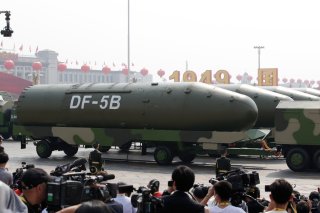Pentagon: China’s WMD Buildup Poses Serious Challenges
China is the number one threat and “presents the most comprehensive and urgent challenge.”
The term weapons of mass destruction (WMD) entered American households in the months leading up to the invasion of Iraq in March 2003. The U.S. Intelligence Community assessed – mistakenly as it later became evident – that Iraqi dictator Saddam Hussein retained an arsenal of weapons of mass destruction and that he might use them in the future. That threat prompted the U.S. to invade Iraq.
WMDs are chemical, biological, radiological, or nuclear weapons that can inflict mass casualties against military forces and civilian populations. They include nuclear bombs, like the ones dropped in Hiroshima and Nagasaki in the final days of World War II, chemical gases, like the ones used in World War I, as well as viruses.
It would take only one such weapon to fall into the wrong hands and cause a catastrophe. And many of America’s enemies, including state and non-state actors, look for such an opportunity to wreak havoc.
A STRATEGY TO COUNTER WEAPONS OF MASS DESTRUCTION
The Pentagon recently released a new strategy on how to counter weapons of mass destruction.
In the accompanying report, the Pentagon identified four strategic priorities: defend the U.S. from an attack; deter the use of weapons of mass destruction against U.S. interests, allies, and partners abroad; enable the joint force to prevail in a “dirty” environment where chemical, biological, radiological, or nuclear weapons have been used; and finally prevent the emergence of new WMD threats.
“The Department must confront the complex and demanding challenges of WMD head-on, within the Department’s overall approach to integrated deterrence and conflict, and with ingenuity and determination. As part of that effort, the Department will plan, campaign through, fight, and win in a WMD-contested environment,” the Pentagon stated.
As the Pentagon highlights in the report, a potential adversary may view weapons of mass destruction as “tools for coercion, warfighting, and constraining U.S. options across the spectrum of conflict.” In other words, potential adversaries can use weapons of mass destruction as a way to deter or restrict U.S. military operations during peace or leading up to war. Moreover, the threat of using weapons of mass destruction can influence decision-making at the early stages of a conflict and give a near-peer adversary, such as China, an advantage.
When it comes to state actors, the Pentagon identifies China, Russia, North Korea, and Iran as the most threatening to U.S. national security and world peace.
China is the number one threat and “presents the most comprehensive and urgent challenge.” The Pentagon assesses that Beijing wants to have 1,000 nuclear warheads by 2030 and 1,500 by 2035. Although China has publicly adopted a “no first use” policy, meaning that it wouldn’t launch a nuke first, Beijing’s lack of transparency raises questions about whether that policy is still in effect. But China presents a much wider threat in WMDs than just nuclear weapons. As the report suggests, China has been working on dual-use agents and toxins that could be weaponized in war.
Russia follows next. Moscow currently retains the largest nuclear weapons arsenal in the world, with over 6,000 warheads. The ongoing hostilities in Ukraine and the bad state of the Russian military have raised concerns regarding the potential use of tactical nuclear weapons against Ukraine. Further, Russia has significant experience with chemical and biological weapons. Through its intelligence services, the Kremlin has used chemical agents to assassinate opponents in the West. The Pentagon assesses that Moscow retains an undeclared chemical weapons program, as well as an offensive biological warfare program.
North Korea comes third. As the more unstable of the bunch, North Korea presents a credible threat to world peace. In 2022, Pyongyang enacted a law to reaffirm its position as a nuclear state, highlighting its willingness to use nuclear weapons as both an offensive and defense measure. North Korea has and is developing mobile short-, intermediate-, and intercontinental nuclear weapons that can strike U.S. bases and allies in the Indo-Pacific, and even reach the U.S. homeland. Moreover, Pyongyang retains a robust chemical and biological arsenal. The Pentagon assesses that North Korea has up to “several thousand metric tons of chemical warfare agents and the capability to produce nerve, blister, blood, and choking agents,” and that it can use artillery, special operations forces, and ballistic missiles to unleash them.
Finally, Iran remains a persistent threat. The Pentagon assesses that Tehran isn’t pursuing a nuclear weapons program right now, but it has the capacity to produce enough fissile material for a nuclear warhead in less than 14 days. When it comes to chemical and biological weapons, like China, Iran is pursuing dual-use research for civilian and military purposes and hasn’t been transparent regarding its nuclear program.
To counter the development and potential use of weapons of mass destruction by its adversaries, the U.S. is focusing on a combination of intelligence, diplomacy, and military readiness.
Stavros Atlamazoglou is a seasoned defense journalist specializing in special operations and national security. He is a Hellenic Army veteran (national service with the 575th Marine Battalion and Army HQ). He holds a BA from the Johns Hopkins University, an MA from the Johns Hopkins’ School of Advanced International Studies (SAIS), and is pursuing a J.D. at Boston College Law School.
This article was first published by Sandboxx News.
Image: Reuters.

